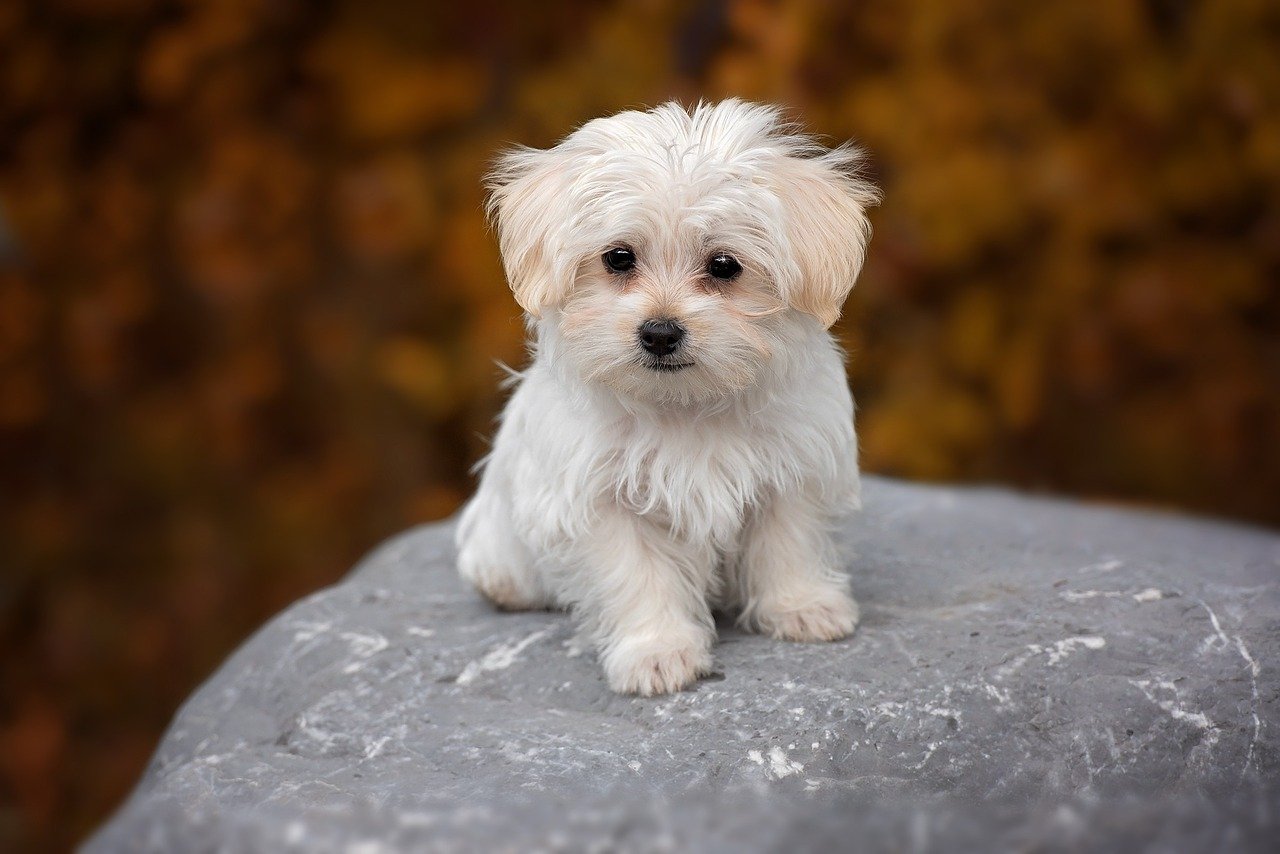Maltese are the best dogs you can imagine. They have such a perfect character and look damn cute and elegant with their beautiful white coat. But do Maltese really only come with white coats or are there other shades as well?
Purebred Maltese only exist in pure white. The AKC standard allows light tan or lemon on the ears. But that is not seen with pleasure. In the FCI breed standard, a pale ivory tint is possible, but also not desired. Maltese as a pure white dog breed has probably existed for thousands of years. However, there are Maltese mixes that are not white.
So if you want to buy a purebred Maltese, the dog will be pure white. However, if you do not plan to take him to dog shows, a slight ivory tint will not matter either.
In the following chapters, we will explain more facts about the beautiful white color of the Maltese. We also discuss other features of their coat and explore the question of whether Maltese have always been white.
Finally, we turn to the question of whether Maltese have any relatives that exist in other colors. And we will tell you if there are any other dog breeds that have exclusively a white coat.
Do Maltese Have To Be White?
The breeding standards of the main pedigree dog breeding associations all stipulate that Maltese must be pure white.
Depending on the association, slight color variations in certain colors are also allowed, but they are not welcome.
At the American Kennel Club (AKC), only color variations in light brown or lemon are allowed. And these variations may also only be on the ears.
The international umbrella organization Fédération Cynologique Internationale (FCI), which simply means International Canine Federation, allows only a pale ivory tint in addition to the pure white coat color.
Of course, there are also Maltese mixes that have a different coat color or at least different shades of color in their coats. However, these are not considered purebred Maltese.
So, in order to bear the proud name Maltese, a dog must have a pure white coat color in addition to some other characteristics.
In addition to coat color, dogs can have markings of other colors on their coats. These markings are created by the fact that certain areas of the skin can have other pigments. These other pigments then provide a different coat color in a small area.
The AKC allows black markings on Maltese. So they are allowed to have small black markings in their coat without losing their status as a Maltese.
The FCI is less generous. In this federation, different colored patches in the coat are not allowed, regardless of the size of the patches.
So it can happen that a Maltese is considered a purebred Maltese in the USA, but not in other countries. So your dog should think twice about where he goes on vacation.
More Interesting Facts About The Maltese Coat
Maltese are known not only for their white coat but also for their long, straight hair. They have a single coat, but it grows densely.
A single coat means that Maltese have no undercoat. In many breeds of dogs, the undercoat serves as insulation to avoid freezing, especially in the cold season.
However, there are some dog breeds that do not have an undercoat. And the Maltese belong to them.
The coat of Maltese is shiny and glossy. It should fall heavily from the body and grow long all over the body.
But this also means that you, as the owner of a Maltese, have a lot of work to do with the coat. His coat needs constant care not to get matted or look unkempt. But more about that in the next chapter.
You will not find curly or frizzy fur on a well-groomed Maltese. Of course, this can be different if you romp through the mud with your Maltese and you don’t bathe him immediately afterward.
And that’s okay, no one forces you to follow the prescribed standards of the breed associations. However, you better not show up at a Maltese show like this and expect to win a prize.
Do Maltese Need A Lot Of Grooming?
As we mentioned above, Maltese is not one of the easiest dogs to care for. You will need to take care of his coat on a daily basis. If this is not for you or you do not have the time for it, the Maltese may not be the right dog breed for you.
You should allow at least half an hour a day for grooming your Maltese. This includes especially brushing and combing your Maltese.
How To Groom Your Maltese
Grooming for your Maltese consists mainly of coat care. And this consists mainly of daily combing and brushing.
Besides, of course, you should not forget regular bathing.
We have put together some valuable tips for the proper care of your Maltese.
Maltese Hair Care
The Maltese should lie on his back for the grooming procedure. This way you can start with the belly hair, as experts recommend.
It is also important to teach your Maltese the grooming ritual while he is still a puppy. This way he can get used to it early and will tolerate it better later. He may even enjoy it.
Another option is to shear your Maltese’s coat regularly. In doing so, you can trim your Maltese’s hair to a length of 1 to 2 inches. Or have it clipped because at least to start with, it may be a good idea to leave this job to a professional groomer.
Once you’ve looked over the professional’s shoulder a few times, you can also try your hand at styling your Maltese’s hair yourself.
By the way, you can leave the fur on the belly and paws a little longer than 2 inches.
To give your Maltese always a nice hairstyle, you should shear it every 2 to 3 months.
Maltese Bathing
When bathing, the situation is a little different. Whether you bathe your Maltese more often than other dog breeds is entirely up to you.
Of course, it also depends on whether you want your dog to participate in a dog show. In that case, he should be freshly bathed and clean.
When bathing, it is important that you use mild dog shampoo. The shampoo should be especially suitable for white fur. We recommend the Lillian Ruff Berry Blue Face and Body Wash*.
This shampoo is specifically formulated for white coats and also further whitens the coat. It even removes tear stains that are often seen on Maltese. It is free of sulfates, paraben, and gluten and is even easy on the eyes if anything happens to get in there.
After you have thoroughly and completely soaped your Maltese, it is important that you rinse the shampoo out thoroughly. There should be no residue of it left in the coat. Always use lukewarm water when bathing your Maltese.
You can also use a conditioner afterward if you like. This will soften the coat, making it easier to comb.
We also recommend the Lillian Ruff Dog Oatmeal Conditioner* for this purpose. This conditioner soothes irritated skin by containing aloe and provides a soft, healthy-looking coat. Even a bath brush is included with the conditioner.
And your Maltese will smell pleasantly of lavender and coconut. A fitting scent for such an elegant dog, don’t you think?
Has The Maltese Coat Always Been White?
Maltese is a very old breed of dogs. They were recognized as a breed by AKC only in 1888 and even by FCI only in 1954, but their history goes back thousands of years.
The Maltese were already appreciated by the ancient Greeks and Romans as lapdogs. There are images on ancient Greek vases made around the year 500 B.C.
And even in the tomb of Ramses II (1301 – 1225 BC) statues of dogs were found, which look confusingly similar to today’s Maltese.
There are also written records from the time of the ancient Greeks. Aristotle, Callimachus, and Pliny the Elder have mentioned or described Maltese.
From all these ancient testimonies we know that the Maltese have been such cute little white dogs for a very long time.
Of course, today it is impossible to trace when exactly Maltese was bred and which breeds were their ancestors. However, it is believed that the Maltese were purposefully bred from a medium-sized shepherd dog.
But we will probably never know exactly.
Do Maltese Have Close Relatives Who Are Not White?
The Maltese belong to the section of Bichons dogs. These are different breeds of small dogs with long or curly hair.
So these are also the closest relatives of our dearest Maltese. And therefore it is perhaps not too surprising that most of the Bichons are also white.
Bichons include the following dog breeds:
- Bichon Frise
- Bolognese
- Havanese
- Maltese
The Havanese takes a special position because it is the only Bichon that is not completely white. His coat is also to a large extent white, but completely white Havanese does not exist.
Most Havanese dogs have a fawn coat in different shades from light fawn to Havanese. Havana is a reddish-brown shade that is also referred to as tobacco. This color may also explain the name Havanese.
There are also two related dog breeds, but they are not counted among the Bichons. The Coton de Tulear is also a completely white dog, while the Lion Dog or Little Lion Dog, like the Havanese, only occurs in color combinations.
So most of the Maltese’s close relatives are actually white as well. There are only a few exceptions to this rule.
Are There Other Dog Breeds That Only Come In White?
Besides the already mentioned Bichons, which exist only with white fur, there are also a few other pure white dog breeds, which do not belong to the Bichons.
The following list shows the recognized dog breeds that exist only with white fur. We have also added a few dog breeds that are slightly different. You can find the possible deviations in brackets.
- Akbash
- Dogo Argentino (may have dark spot on head)
- Japanese Spitz
- Kuvasz
- Maremmano-Abruzzese Sheepdog
- Pyrenean Mountain Dog (white or light yellow)
- Samoyed (white or cream)
- White Swiss Shepherd Dog
Considering that there are 197 dog breeds recognized by AKC and 344 by FCI, there are not so many that exist only with a white coat. And our Maltese is one of them.
Final Thoughts
Maltese are so popular also because of their beautiful white coat. In fact, they are one of only a few dog breeds that exist solely with a white coat.
But the beautiful coat of the Maltese also has its price. If you want to buy a Maltese, you will have to invest a lot of time in its coat. Daily coat care should be a fixed ritual for every Maltese.
Their wonderful white fur Maltese have not only recently. There are even records from ancient times where Maltese were painted or described. So they are a very old dog breed.
Most other dogs, which also exist only with white fur, are close relatives of the Maltese. So it is in the genes of this dog to strut around so elegantly.
So take good care of your Maltese’s coat, it needs a lot of care to shine so beautifully.


